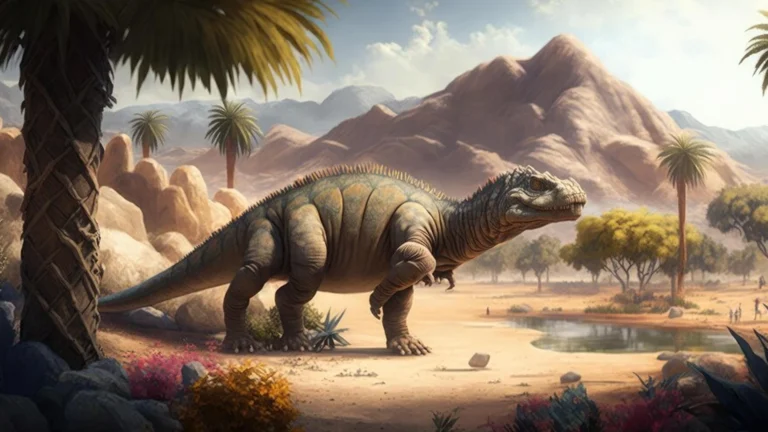The Branchiosaurus, often referred to as a “lost aquatic dinosaur,” is one of the most fascinating and enigmatic species to have roamed prehistoric Earth. Unlike many of the familiar dinosaurs of the Mesozoic Era, the Branchiosaurus stands out due to its aquatic lifestyle and unique adaptations. Though not as well-known as other dinosaur species, the Branchiosaurus has captured the imagination of paleontologists and enthusiasts alike. In this article, we will delve into the mysteries of this aquatic creature, exploring its physical traits, its role in the ancient ecosystem, and the reasons it remains an intriguing subject of study.
TRENDING
Explore The Kiamichi Mountains: Hiking, Camping & More
What Was The Branchiosaurus?
The Branchiosaurus is often classified as an aquatic reptile, though its classification has been the subject of some debate. It was originally discovered in the fossil record and is believed to have existed during the late Triassic to early Jurassic periods, approximately 210 to 190 million years ago. While not a dinosaur in the strictest sense (since dinosaurs are typically land-dwelling creatures), the Branchiosaurus is closely related to other early reptiles and shares many features with marine reptiles like ichthyosaurs and plesiosaurs.
Physical Characteristics of Branchiosaurus
The Branchiosaurus is characterized by several distinct features that set it apart from other prehistoric creatures. Most notably, it had a long, streamlined body that made it highly adapted to an aquatic environment. Its body shape and size suggest that it was an excellent swimmer, likely preying on fish, smaller reptiles, and other marine life.
- Size and Shape: Branchiosaurus was relatively small compared to other marine reptiles of its time, growing to lengths of about 5 to 6 feet. Its body was elongated, with a long tail that helped it navigate through water with remarkable agility.
- Limbs and Movement: The limbs of the Branchiosaurus were adapted for swimming, with webbed feet and elongated digits. It likely used its limbs in a manner similar to modern-day seals or sea lions.
- Head and Mouth: It had a relatively small head with sharp, conical teeth, ideal for catching fish and small marine prey. Its jaws were not as massive as those of other marine predators, suggesting it relied on speed and agility to capture its meals.
- Gill Slits and Breathing: As an aquatic creature, the Branchiosaurus had gill slits, allowing it to extract oxygen from water. This adaptation was essential for its survival in aquatic environments, as it could not breathe air like most terrestrial dinosaurs.
Habitat and Ecosystem
The Branchiosaurus lived in shallow, coastal waters, where it could easily find its prey. Fossil evidence suggests that it preferred areas with abundant fish populations, likely inhabiting estuaries, lagoons, and possibly even coral reefs. These environments provided not only food but also protection from larger predators.
In terms of the broader ecosystem, the Branchiosaurus coexisted with a variety of other prehistoric marine life forms. While it was relatively small compared to some of its contemporaries, it still played an important role in the food chain. Its prey likely included fish, cephalopods, and smaller marine reptiles, contributing to the biodiversity of its environment.
Evolutionary Significance Of The Branchiosaurus
The Branchiosaurus holds an important place in the evolutionary history of reptiles. It is one of the earliest examples of an aquatic reptile that was fully adapted to life in the water. The features found in Branchiosaurus are considered precursors to those seen in later marine reptiles, including the ichthyosaurs and plesiosaurs, which dominated the oceans during the Mesozoic era.
The adaptation of land-based reptiles to aquatic environments is an intriguing process that marks a significant milestone in the evolution of life on Earth. By studying creatures like the Branchiosaurus, scientists can gain insights into how vertebrates transitioned from land to water and how those changes shaped the course of evolutionary history.
Evolutionary Connections
Although the Branchiosaurus is often considered a distant relative of modern-day reptiles, it is also linked to some of the earliest forms of amphibians. Its classification as an amphibious or semi-aquatic species reflects its transitional role in the broader context of reptile evolution. It is believed that species like Branchiosaurus laid the foundation for more specialized marine reptiles, which would evolve in the following millions of years.
In terms of direct descendants, the Branchiosaurus does not have living relatives today. However, its evolutionary lineage helped shape the path that led to other aquatic reptiles, such as the plesiosaurs and mosasaurs, which would dominate marine ecosystems during the Cretaceous period.
The Mystery Of The Branchiosaurus Extinction
Like many prehistoric species, the Branchiosaurus eventually became extinct. The exact reasons for its extinction are not entirely clear, but it is believed to have been related to environmental changes that occurred during the Triassic-Jurassic transition. This period was marked by significant volcanic activity, fluctuating sea levels, and climate changes, all of which could have impacted the delicate balance of aquatic ecosystems.
The Branchiosaurus may have been unable to adapt to these changes, especially as the composition of marine life shifted. The rise of more powerful predators, such as large marine reptiles, could have also contributed to its eventual disappearance.
Fossil Evidence and Discoveries
The fossil record of the Branchiosaurus is relatively sparse, which is part of the reason why so much about this creature remains a mystery. Fossils of Branchiosaurus have been discovered in various locations, primarily in what is now Europe, though more comprehensive excavation efforts could yield further insights into its biology and behavior.
The few fossils that have been uncovered provide critical clues about its anatomy, diet, and behavior. Most of these fossils consist of partial skeletons, including fragments of limbs, jaws, and vertebrae. These fossils are usually found in marine sedimentary layers, further supporting the theory that Branchiosaurus was a fully aquatic species.
Why The Branchiosaurus Matters In Paleontology
Despite the limited number of fossils and the mystery surrounding its extinction, the Branchiosaurus is an important species for paleontologists. It provides valuable information about the early evolution of aquatic reptiles and their adaptations to marine environments. By studying creatures like the Branchiosaurus, researchers can better understand how early reptiles evolved, diversified, and interacted with other species during the Mesozoic Era.
Furthermore, the Branchiosaurus is a reminder of the vast diversity of prehistoric life that once existed on Earth. While it may not be as famous as dinosaurs like Tyrannosaurus rex or Triceratops, the Branchiosaurus represents a vital link in the evolutionary chain, offering insights into the incredible adaptations that have allowed life to thrive in a variety of ecosystems over millions of years.
Conclusion
The Branchiosaurus is a captivating and somewhat mysterious species that highlights the incredible diversity of life in the Mesozoic era. As an early aquatic reptile, it played an important role in the ecosystems of its time and paved the way for the more specialized marine reptiles that would later dominate the oceans. Though much about its life and extinction remains unknown, ongoing research and fossil discoveries will undoubtedly continue to shed light on this fascinating “lost” species.
By studying creatures like the Branchiosaurus, scientists are able to reconstruct the past and gain a deeper understanding of the evolutionary forces that shaped the planet’s biodiversity. As we learn more about these early aquatic reptiles, we are reminded of the ever-changing nature of life on Earth and the complex web of relationships that have existed between species for millions of years.
ALSO READ: History Of LineDancing: Origins And Evolution Explained
FAQs
What is Branchiosaurus?
Branchiosaurus is an extinct aquatic reptile that lived during the Triassic to early Jurassic periods. It is characterized by its streamlined body, long tail, webbed limbs, and gill slits, which made it well-adapted to an aquatic lifestyle. It is not technically a dinosaur, but shares many features with early reptiles and marine reptiles.
When did the Branchiosaurus live?
The Branchiosaurus lived approximately 210 to 190 million years ago, during the late Triassic and early Jurassic periods. This was a time when Earth’s ecosystems were rapidly evolving, with the first true dinosaurs beginning to appear.
How did the Branchiosaurus move in water?
The Branchiosaurus had a long, slender body with webbed feet, which helped it move efficiently in water. Its tail also played a key role in propelling it through aquatic environments, much like modern-day marine animals.
What did the Branchiosaurus eat?
The Branchiosaurus was a carnivore, primarily feeding on fish, cephalopods, and smaller marine reptiles. Its sharp teeth and agile body allowed it to capture prey with speed and precision.
What caused the extinction of Branchiosaurus?
The exact cause of the Branchiosaurus’s extinction is not fully known, but it is believed to have been linked to environmental changes during the Triassic-Jurassic transition, including climate shifts, volcanic activity, and the rise of larger marine predators.

